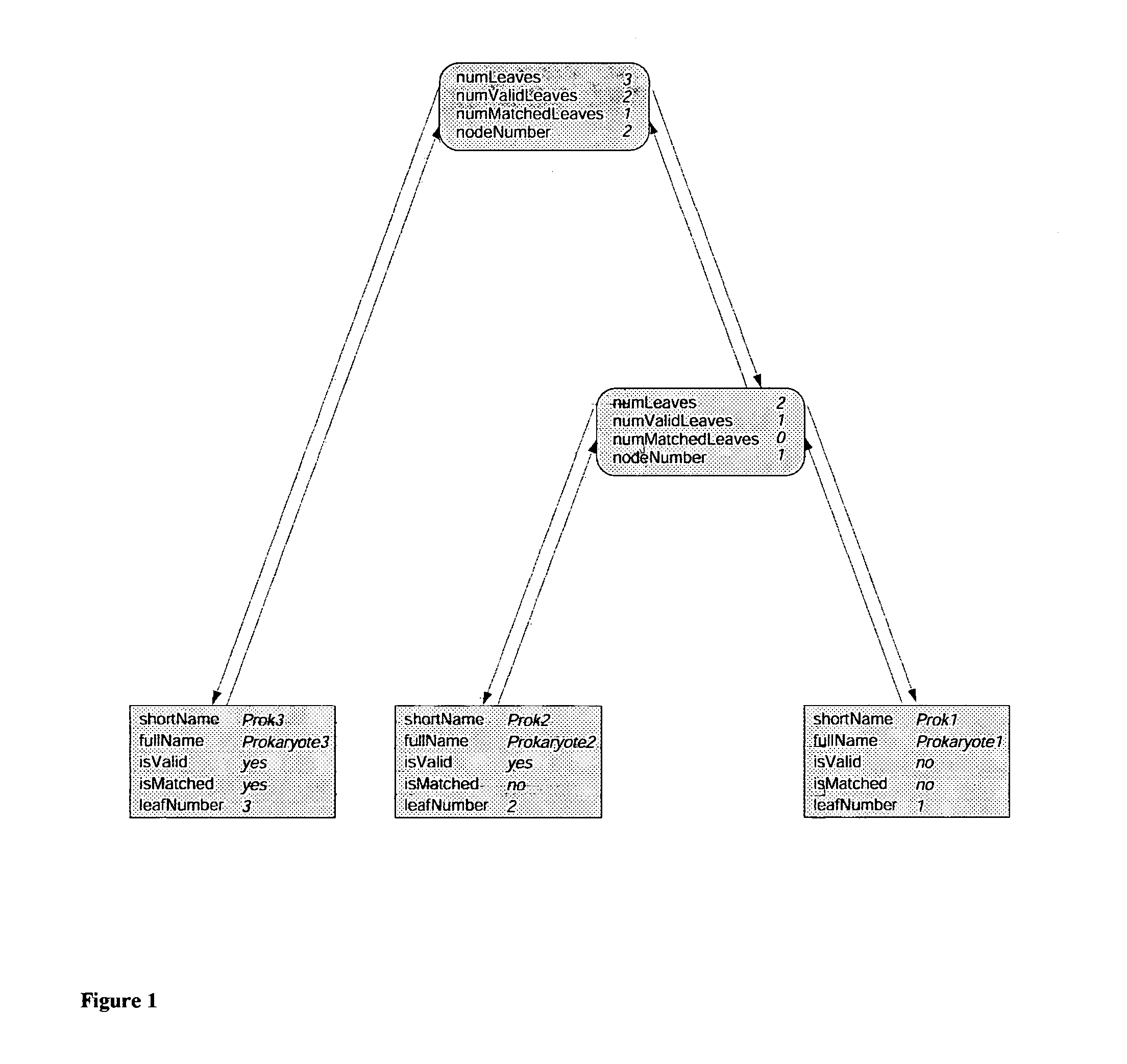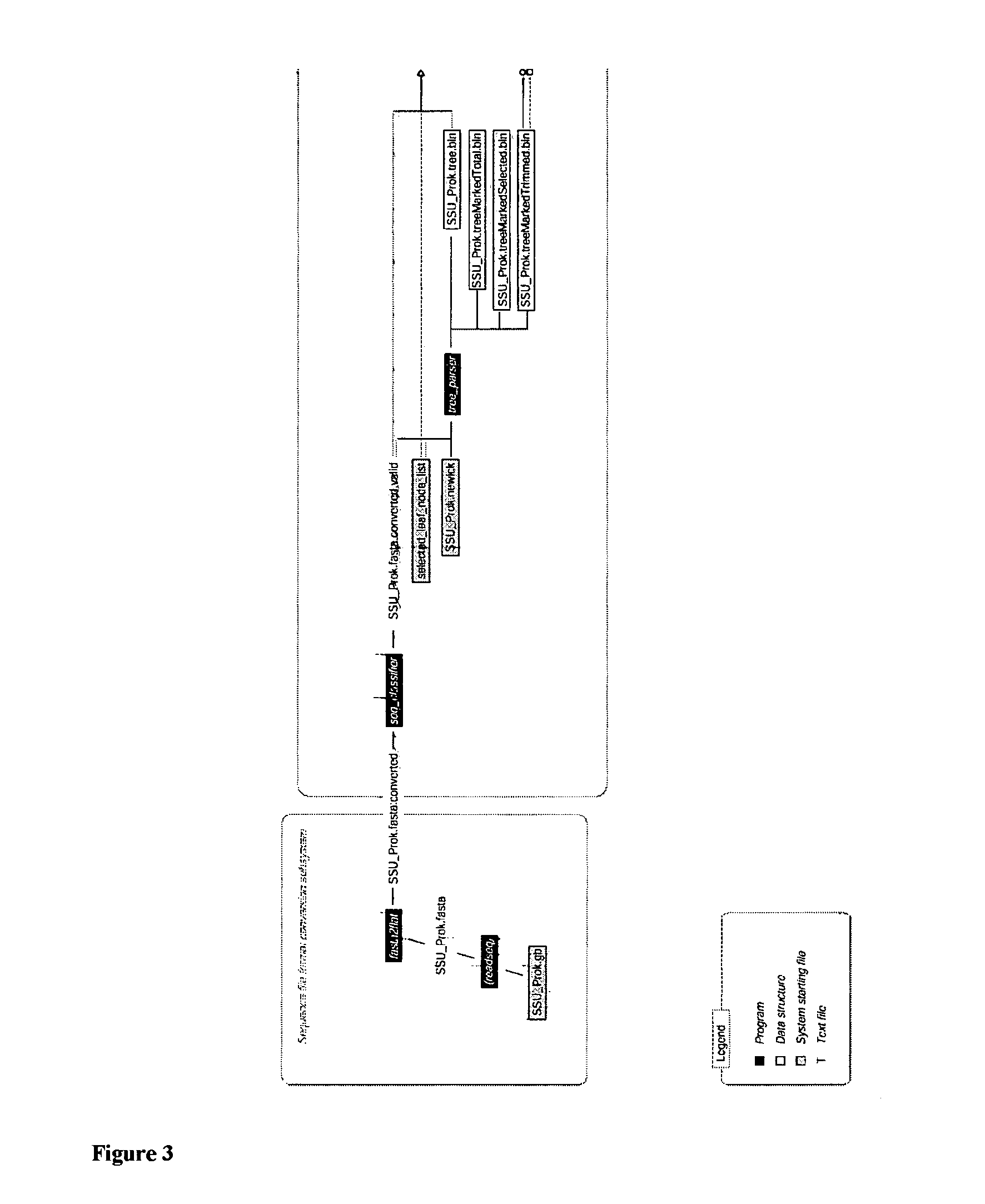Methods for determining the genetic affinity of microorganisms and viruses
a technology of genetic affinity and microorganisms, applied in the field of methods for determining the genetic affinity of microorganisms and viruses, can solve the problems of inability to sequence the entire rna, it is very difficult to develop a classification system,
- Summary
- Abstract
- Description
- Claims
- Application Information
AI Technical Summary
Benefits of technology
Problems solved by technology
Method used
Image
Examples
example 1
A Local Region of the Tree & its Associated Signatures
[0148]The purpose of this example is to better illustrate the relationship between the signature sequences found and the nodes of the tree used in a more detailed level. Table F, lists only the results with reference to a local region of the comprehensive tree. Before trimming this region contained 16S rRNAs representing 38 organisms. A total of 23 of these sequences were of the very highest quality but many of them were very similar so a total of 12 sequences were selected for final inclusion in the representative tree. This local region of the representative tree is shown in FIG. 12. The numbers of nonameric, undecameric and 15-mer signature sequences at each of the 11 branch tree nodes in this 12 organism sub-tree in different ranges of quality levels are summarized in Table F. Tree node 5547 does not have any signatures at the Qs 1.0 level whereas its parent branch, node 5549, has 14 perfect nonameric / undecameric / 15-mer signa...
example 2
In Silico Hybridization
[0149]Once the characteristic oligonucleotides (signature sequences) from 16S rRNA sequence dataset are identified, they can be used to implement in silico hybridization (This is not carried out in the laboratory. Instead, it is performed virtually by a computer program, thus, in silico). This procedure can be either executed as a standard experimental routine or in this case as a quick test of the validity of the signatures, which have been identified.
[0150]Since these characteristic oligonucleotides were derived from the selected valid 16S rRNA sequences using the corresponding representative tree, several valid 16S rRNAs that were not selected to make the representative tree were chosen as 16S rRNAs from “unidentified” bacteria. Program hybridize was used to perform in silico hybridization between the unknown 16S rRNAs and the characteristic oligonucleotides. The unknowns were thus placed in their predicted phylogenetic neighborhoods in the representative t...
example 3
Soil Samples
[0170]16S rRNA is purified from an unknown organism isolated from soil and amplified by RT-PCR using primers directed to conserved regions and flanking a variable region of the molecule. The PCR products are subjected to digestion by a restriction endonuclease, flourescently labeled with cy5, and then hybridized to an array of all possible 8-mer peptide nucleic acids. After washing, the pattern of hybridization is observed by confocal laser fluorescence scanning, and interpreted in terms of the known signature sequences for bacteria and the organism is assigned to the genus Nocardia.
PUM
| Property | Measurement | Unit |
|---|---|---|
| Fraction | aaaaa | aaaaa |
| Electrical conductance | aaaaa | aaaaa |
| Time | aaaaa | aaaaa |
Abstract
Description
Claims
Application Information
 Login to View More
Login to View More - R&D
- Intellectual Property
- Life Sciences
- Materials
- Tech Scout
- Unparalleled Data Quality
- Higher Quality Content
- 60% Fewer Hallucinations
Browse by: Latest US Patents, China's latest patents, Technical Efficacy Thesaurus, Application Domain, Technology Topic, Popular Technical Reports.
© 2025 PatSnap. All rights reserved.Legal|Privacy policy|Modern Slavery Act Transparency Statement|Sitemap|About US| Contact US: help@patsnap.com



